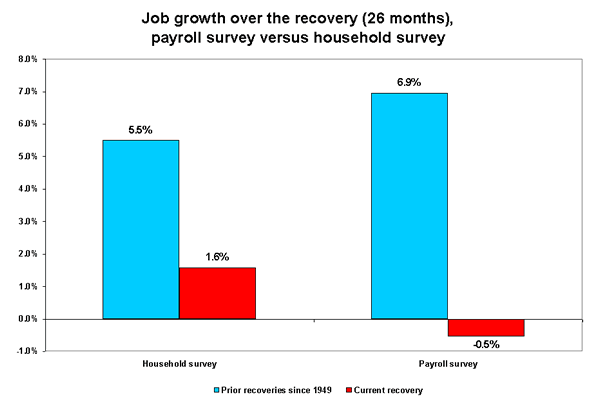See Snapshots Archive.
Snapshot for February 25, 2004.
Different sets of employment numbers tell the same story: Slow job growth
There are two surveys used to measure employment numbers: the payroll survey and the household survey. The payroll survey is best for tracking levels of employment, while the household survey measures unemployment and employment-to-population ratios. As the payroll survey shows, employment growth in this recovery is -0.5%, compared to an average growth of 6.9% in the previous recoveries since 1949 (see figure). In fact, this is the first recovery that net job growth 26 months into the recovery has been negative.

In terms of measuring job growth, the payroll survey is the survey of preference for experts such as the Congressional Budget Office1, the Bureau of Labor Statistics2, the Council of Economic Advisers3, and Federal Reserve Board Chairman Alan Greenspan4. While the experts clearly agree that the payroll survey is a better measure of employment than the household survey, some continue to use the household survey, arguing that growth in entrepreneurship overwhelms the job losses recorded in the payroll survey because the latter does not include self-employment.5
But even if the household numbers were used to measure job growth, the rate of growth at this point in the recovery is less than one-third the size of the average job growth in all other recoveries since 1949. The figure shows a growth rate of 1.6% in this recovery as compared to an average rate of 5.5% in the previous recoveries since 1949. Even the household employment numbers, which include the self-employed, illustrate a staggeringly slow recovery from the recession in 2001.
Note: For more information about the comparison of surveys, see the EPI Briefing Paper Measuring Employment Since the Recovery.
This week’s snapshot was written by EPI economist Elise Gould.
1 In August, 2003, the Congressional Budget Office stated that “the establishment survey better reflect the state of labor markets.”
2 In September 2003, the Commissioner of the Bureau of Labor Statistics, argued that “it is our judgment that the payroll survey provides more reliable information on the current trend in wage and salary employment.”
3 In the Economic Report of the President 2004, the Council of Economic Advisers asserted that the “establishment survey’s larger base of respondents means the calculated margin of error of its estimates is significantly smaller than that associated with the household survey estimates. In addition, the establishment survey is revised annually to match complete payroll records from the universe of establishments participating in state unemployment insurance programs, while the household survey is not.”
4 On February 12, 2004, in his testimony before the Senate Banking Committee, Chairman Alan Greenspan stated that “the payroll series is the more accurate number.” In addition, “it is apparent that a goodly part of the problem [of different survey employment estimates] is that the household employment have been overestimated largely because of what we perceive to be an overestimate of population.”
5 Rea S. Hederman, Jr., in Strong Economic Growth Continues, Heritage Foundation WebMemo #379, December 5, 2003, stated, “a primary failing of the payroll survey is its inability to estimate self-employed workers. Some reports show that the number of self-employed workers could have increased by over 400,000 in 2003.”
